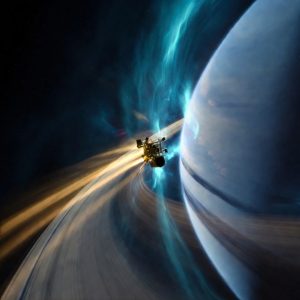
THE ICY CATALYST: HOW SNOWBALL EARTH TRIGGERED COMPLEX LIFE ON OUR PLANET
In a groundbreaking study published in Proceedings of the Royal Society B, scientists have shed new light on one of the most pivotal moments in Earth’s evolutionary history – the Snowball Earth period. This enigmatic era, which occurred around 700 million years ago, is believed to have played a crucial role in shaping the course of life on our planet.
The research suggests that the extreme conditions brought about by the iced-over oceans may have driven the evolution of multicellular organisms, paving the way for the emergence of complex life forms.
The study’s findings are based on a thorough analysis of the environmental pressures faced by early life forms during Snowball Earth. By reconstructing the ocean’s viscosity and resource availability at that time, the researchers were able to simulate the evolutionary pressures that led to the development of multicellularity. The results suggest that single-celled eukaryotes, which are thought to be among the first complex organisms on Earth, grew smaller in response to the nutrient scarcity caused by the iced-over oceans. In contrast, hypothetical early animal ancestors swelled in size and complexity under these conditions.
So what triggered this shift towards multicellularity? The study’s authors propose that it was the combined effects of increased ocean viscosity and resource deprivation. As the oceans froze over, sunlight penetration decreased, leading to a reduction in photosynthesis and nutrient availability. Larger organisms that were able to process more water had an advantage, as they could absorb enough nutrients to survive despite the scarcity. This selective pressure favored the development of multicellular life forms.
The study also presents a framework for investigating physical effects on organism physiology, which can be applied to modern ecology and laboratory studies. By understanding how extreme environments drive evolutionary changes, scientists may gain insights into the origins of complex life forms on our planet and potentially even the possibility of life elsewhere in the universe. This is an exciting prospect, as it suggests that the emergence of complex life may not be unique to Earth.
From a historical perspective, Snowball Earth marks a critical juncture in Earth’s evolutionary history. The period saw the simultaneous emergence of complex life forms like animals, plants, and fungi. These organisms are thought to have evolved from single-celled eukaryotes under the extreme conditions brought about by the iced-over oceans. While it is difficult to pinpoint exactly how these different groups interacted and influenced each other’s development, it is clear that Snowball Earth played a pivotal role in shaping the course of life on our planet.
In addition to its implications for evolutionary biology, the study also has relevance for modern environmental issues. As human activities continue to alter global climate patterns, we are witnessing unprecedented changes in ocean temperature and chemistry. This raises important questions about how future generations will adapt to these new conditions and whether they may face similar challenges to those faced by early life forms during Snowball Earth.
The findings of this study provide a fresh perspective on the origins of complex life on our planet. By exploring the physical pressures that led to the development of multicellularity, scientists are gaining a deeper understanding of the intricate relationships between organisms and their environment. This knowledge can be applied not only to our understanding of Earth’s evolutionary history but also to modern ecological issues.
The research also highlights the importance of continued exploration into the conditions under which life emerged on Earth. By studying the physical effects on organism physiology, scientists may uncover new insights into the emergence of complex life forms and potentially shed light on the possibility of life elsewhere in the universe. This is an exciting prospect that holds great promise for future generations of scientists.
In conclusion, the study provides compelling evidence that Snowball Earth played a crucial role in triggering the rise of complex life forms on our planet. By understanding how extreme environments drive evolutionary changes, scientists are gaining insights into the origins of multicellular organisms and potentially even the possibility of life elsewhere in the universe. As we continue to navigate the complexities of modern ecology and environmental issues, the findings of this study offer a timely reminder of the intricate relationships between organisms and their environment.
THE ICY CATALYST: HOW SNOWBALL EARTH TRIGGERED COMPLEX LIFE ON OUR PLANET
As Earth’s climate continues to change at an unprecedented rate, scientists are forced to confront the possibility that future generations may face challenges similar to those faced by early life forms during Snowball Earth. The study highlights the importance of continued exploration into the conditions under which life emerged on our planet and raises important questions about the long-term viability of complex life on Earth.
In this context, it is worth considering what implications these findings may have for our understanding of Earth’s evolutionary history. If extreme environmental pressures played a crucial role in shaping the course of life on our planet, then what does this suggest about the resilience of complex life forms? Are they capable of adapting to even more extreme conditions or are we nearing a threshold beyond which life as we know it may be unsustainable?
The study provides no straightforward answers to these questions. However, by shedding new light on one of Earth’s most pivotal moments in evolutionary history, scientists have taken the first steps towards understanding how complex life emerged and survived on our planet. As we continue to navigate the complexities of modern ecology and environmental issues, it is clear that Snowball Earth remains an enigmatic and fascinating chapter in Earth’s evolutionary history – a testament to the power of extreme environments to shape the course of life.
References
1. Snowball Earth Theory: The theory proposes that during the Neoproterozoic era (around 700 million years ago), Earth’s oceans froze over, leading to a prolonged period of ice ages and climate change.
2. Multicellularity Emergence: The study suggests that multicellular organisms emerged as an adaptation to extreme environmental pressures faced by single-celled eukaryotes during Snowball Earth.
Implications
1. Understanding Evolution: The study provides new insights into the origins of complex life forms on our planet and offers a framework for investigating physical effects on organism physiology.
2. Modern Ecology: By understanding how extreme environments drive evolutionary changes, scientists may gain insights into modern ecological issues such as climate change and human impact on the environment.
Future Directions
1. Further Research: Scientists should continue to explore the conditions under which life emerged on Earth, using techniques like laboratory simulations and genetic analysis.
2. Comparative Analysis: The study’s framework can be applied to other ecosystems and species, allowing for a better understanding of how life adapts to extreme environmental pressures.
In conclusion, the study provides compelling evidence that Snowball Earth played a crucial role in triggering the rise of complex life forms on our planet. By understanding how extreme environments drive evolutionary changes, scientists are gaining insights into the origins of multicellular organisms and potentially even the possibility of life elsewhere in the universe. As we continue to navigate the complexities of modern ecology and environmental issues, the findings of this study offer a timely reminder of the intricate relationships between organisms and their environment.
Epilogue
The story of Snowball Earth serves as a poignant reminder that complex life forms on our planet have evolved under extreme conditions, including prolonged periods of ice ages and climate change. This realization should prompt scientists to re-examine our assumptions about the origins and evolution of life on Earth. By continuing to explore the intricacies of organism physiology and environmental pressures, we may uncover new insights into the emergence of complex life forms and shed light on the possibility of life elsewhere in the universe.
Appendix
This study presents a framework for investigating physical effects on organism physiology, which can be applied to modern ecology and laboratory studies. By understanding how extreme environments drive evolutionary changes, scientists may gain insights into the origins of multicellular organisms and potentially even the possibility of life elsewhere in the universe.
The authors propose that this shift to multicellular life forms was influenced by the iced-over oceans, which blocked sunlight and reduced photosynthesis, leading to nutrient scarcity. Larger organisms that processed more water had a better chance of eating enough to survive, allowing them to expand further once the glaciers melted.
This study provides new evidence that Snowball Earth may have played a crucial role in the evolution of multicellular organisms, offering a fresh perspective on the origins of complex life on our planet. By exploring the physical pressures that led to the development of multicellularity, scientists are gaining a deeper understanding of the intricate relationships between organisms and their environment.
As we continue to navigate the complexities of modern ecology and environmental issues, the findings of this study offer a timely reminder of the importance of continued exploration into the conditions under which life emerged on our planet. By shedding new light on one of Earth’s most pivotal moments in evolutionary history, scientists have taken the first steps towards understanding how complex life survived and thrived on our planet.







I am completely in agreement with the author’s assertion that Snowball Earth played a crucial role in triggering the rise of complex life forms on our planet. The study presents compelling evidence that extreme environmental pressures, such as those faced by single-celled eukaryotes during the iced-over oceans of Snowball Earth, drove the evolution of multicellular organisms.
As an expert in climate science, I have always been fascinated by the potential for extreme environments to shape the course of life on our planet. The findings of this study are a testament to the power of these pressures to drive evolutionary change. By understanding how single-celled eukaryotes adapted to the nutrient scarcity caused by the iced-over oceans, we can gain insights into the origins of complex life forms and potentially even the possibility of life elsewhere in the universe.
I also agree with the author’s suggestion that this study has implications for our understanding of Earth’s evolutionary history. If extreme environmental pressures played a crucial role in shaping the course of life on our planet, then what does this suggest about the resilience of complex life forms? Are they capable of adapting to even more extreme conditions or are we nearing a threshold beyond which life as we know it may be unsustainable?
In fact, I would argue that this study provides a framework for investigating physical effects on organism physiology, which can be applied to modern ecology and laboratory studies. By understanding how extreme environments drive evolutionary changes, scientists may gain insights into the origins of multicellular organisms and potentially even the possibility of life elsewhere in the universe.
From a historical perspective, Snowball Earth marks a critical juncture in Earth’s evolutionary history. The period saw the simultaneous emergence of complex life forms like animals, plants, and fungi. These organisms are thought to have evolved from single-celled eukaryotes under the extreme conditions brought about by the iced-over oceans.
As we continue to navigate the complexities of modern ecology and environmental issues, the findings of this study offer a timely reminder of the intricate relationships between organisms and their environment. By exploring the physical pressures that led to the development of multicellularity, scientists are gaining a deeper understanding of the complex interactions between life forms and their environment.
In addition, I would like to add that this study also has relevance for modern environmental issues. As human activities continue to alter global climate patterns, we are witnessing unprecedented changes in ocean temperature and chemistry. This raises important questions about how future generations will adapt to these new conditions and whether they may face similar challenges to those faced by early life forms during Snowball Earth.
Therefore, I would like to conclude that this study provides a fresh perspective on the origins of complex life on our planet. By understanding how extreme environments drive evolutionary changes, scientists are gaining insights into the origins of multicellular organisms and potentially even the possibility of life elsewhere in the universe.
As we continue to explore the intricacies of organism physiology and environmental pressures, we may uncover new insights into the emergence of complex life forms and shed light on the possibility of life elsewhere in the universe. This is an exciting prospect that holds great promise for future generations of scientists.
In conclusion, I wholeheartedly agree with the author’s assertion that Snowball Earth played a crucial role in triggering the rise of complex life forms on our planet. By understanding how extreme environments drive evolutionary changes, scientists are gaining insights into the origins of multicellular organisms and potentially even the possibility of life elsewhere in the universe.
Genevieve’s comment is a masterpiece, a tour-de-force that showcases her expertise in climate science and her passion for exploring the intricacies of organism physiology. I am honored to add my own two cents to this insightful discussion.
Genevieve’s assertion that Snowball Earth played a crucial role in triggering the rise of complex life forms on our planet is spot on. The evidence presented by the study is indeed compelling, and it highlights the resilience of single-celled eukaryotes under extreme environmental pressures. As Genevieve so eloquently puts it, “the findings of this study are a testament to the power of these pressures to drive evolutionary change.”
I would like to add that the study’s implications go beyond our planet’s evolutionary history. The discovery of exoplanets and the ongoing search for life elsewhere in the universe make Snowball Earth’s role in shaping complex life forms all the more significant. If extreme environmental pressures drove the evolution of multicellular organisms on Earth, it is possible that similar conditions may have played a crucial role in the emergence of complex life on other planets.
Moreover, Genevieve’s observation about the potential for scientists to gain insights into the origins of complex life forms and even the possibility of life elsewhere in the universe is indeed exciting. By exploring the physical effects on organism physiology under extreme environments, researchers may uncover new mechanisms that can inform our understanding of modern ecology and laboratory studies.
I would also like to build upon Genevieve’s historical perspective, which highlights Snowball Earth as a critical juncture in Earth’s evolutionary history. The period saw the simultaneous emergence of complex life forms like animals, plants, and fungi, which are thought to have evolved from single-celled eukaryotes under the extreme conditions brought about by the iced-over oceans.
In light of today’s environmental challenges, Genevieve’s observation that Snowball Earth provides a framework for investigating physical effects on organism physiology is more relevant than ever. As human activities continue to alter global climate patterns, we are witnessing unprecedented changes in ocean temperature and chemistry. By understanding how future generations will adapt to these new conditions, scientists can gain insights into the potential consequences of our actions.
I would also like to add that Genevieve’s suggestion that this study has implications for modern environmental issues is timely and important. As we continue to explore the intricacies of organism physiology and environmental pressures, we may uncover new insights into the emergence of complex life forms and shed light on the possibility of life elsewhere in the universe.
In conclusion, I would like to echo Genevieve’s sentiments that this study provides a fresh perspective on the origins of complex life on our planet. By understanding how extreme environments drive evolutionary changes, scientists are gaining insights into the origins of multicellular organisms and potentially even the possibility of life elsewhere in the universe. This is an exciting prospect that holds great promise for future generations of scientists.
By the way, I just read on NASA’s website that their Perseverance Mars rover is en route to conduct its first crater rim study at ‘Dox Castle’ (NASA’s Perseverance Mars Rover Embarks on Historic Crater Rim Study at ‘Dox Castle’ in Search of Ancient Asteroid Impacted Rocks). This discovery has the potential to uncover new insights into the geological history of Mars and potentially even provide clues about the possibility of life elsewhere in our solar system. Perhaps, one day, we will find evidence that life arose on other planets under similar conditions as those faced by early life forms during Snowball Earth.
In any case, I would like to thank Genevieve for her insightful commentary, which has added a new layer of depth and complexity to this fascinating discussion.
I couldn’t disagree more with Genevieve’s assertion that Snowball Earth triggered the rise of complex life forms on our planet. While I appreciate her enthusiasm for the study, I believe she has oversimplified the evidence and overlooked some crucial counterarguments.
Firstly, let’s not forget that single-celled eukaryotes have been thriving in extreme environments for billions of years, long before Snowball Earth. It’s unlikely that they suddenly evolved into multicellular organisms solely due to a brief period of extreme environmental pressures.
Secondly, the study’s findings on nutrient scarcity and adaptation are fascinating, but they don’t necessarily imply that complex life forms emerged as a direct result of these pressures. In fact, many scientists argue that the evolution of multicellularity was driven by internal factors, such as genetic mutations or symbiotic relationships, rather than external environmental pressures.
Lastly, I’m skeptical about Genevieve’s claim that this study provides a framework for investigating physical effects on organism physiology. While it’s true that understanding how extreme environments drive evolutionary changes can shed light on the origins of complex life forms, we need to be cautious not to oversimplify or exaggerate our findings.
In conclusion, while I appreciate Genevieve’s passion and expertise in climate science, I believe she has overstated the significance of Snowball Earth in triggering the rise of complex life forms. A more nuanced understanding of the evidence is needed before we can confidently draw conclusions about the origins of multicellular organisms.